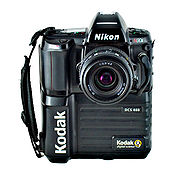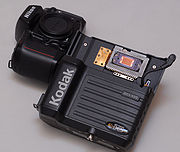
Kodak DCS 400 series
Encyclopedia


Nikon
, also known as just Nikon, is a multinational corporation headquartered in Tokyo, Japan, specializing in optics and imaging. Its products include cameras, binoculars, microscopes, measurement instruments, and the steppers used in the photolithography steps of semiconductor fabrication, of which...
based digital SLR camera
Camera
A camera is a device that records and stores images. These images may be still photographs or moving images such as videos or movies. The term camera comes from the camera obscura , an early mechanism for projecting images...
s with sensor and added electronics produced by Eastman Kodak
Eastman Kodak
Eastman Kodak Company is a multinational imaging and photographic equipment, materials and services company headquarted in Rochester, New York, United States. It was founded by George Eastman in 1892....
.
The cameras in this series include the 1.5-megapixel DCS 420 (introduced in August 1994), the 1.5-mpx DCS 410 (introduced in 1996), and the 6.2-mpx DCS 460 (introduced in March 1995). In addition, Kodak sold a version of the back from the DCS 460 adapted for medium format bodies as the DCS 465. Kodak also made a camera especially for Associated Press. It was called NC2000 (based on the Nikon N90/F90), later upgraded to NC2000e (based on the Nikon N90s/F90x) using many of the same components as was used for the DCS 400 series. Kodak also used the imaging component and electronics of the DCS 420 to produce a digital version of the Nikonos
Nikonos
Nikonos is the name of a series of 35 mm film cameras specifically designed for underwater photography launched by Nikon in 1963. The early Nikonos cameras were improvements of the Calypso camera, which was an original design by Jacques-Yves Cousteau and Belgian engineer Jean de Wouters...
underwater camera, which was produced in limited numbers for military and scientific applications as the Kodak DCS 425.
In addition to the standard colour version, Kodak made monochrome and infrared versions of the DCS 420, which were made to order as the 420m and 420IR respectively. There were also monochrome versions of the DCS 460 and DCS 465, with the same nomeclature. The non-colour versions are very rare and tend to collect high prices at auctions and second-hand brokers.
The DCS 400-series were based on the Nikon N90s 35 mm
135 film
The term 135 was introduced by Kodak in 1934 as a designation for cartridge film wide, specifically for still photography. It quickly grew in popularity, surpassing 120 film by the late 1960s to become the most popular photographic film format...
film camera (called F90x in Europe). The DCS 410 and some early versions of the DCS 420 and 460 were based on the Nikon N90/F90 body. After the Nikon N90s/F90x was introduced in late 1994, Kodak started using that model as basis for the DCS 400-series. The camera body could be converted back to a film camera by removing the digital component, and replacing the digital back with a standard back.
All cameras in the series used a 12 bit/channel CCD. The 1.5 Mpx sensor used in the DCS 410 and DCS 420 measures 9.2x13.8 mm (2.6x crop factor
Crop factor
In digital photography, a crop factor is related to the ratio of the dimensions of a camera's imaging area compared to a reference format; most often, this term is applied to digital cameras, relative to 35 mm film format as a reference. In the case of digital cameras, the imaging device would be a...
compared to the 35 mm
135 film
The term 135 was introduced by Kodak in 1934 as a designation for cartridge film wide, specifically for still photography. It quickly grew in popularity, surpassing 120 film by the late 1960s to become the most popular photographic film format...
film format). The 6.2 Mpx sensor used in the DCS 460 and DCS 465 measures 18.4x27.6mm (1.3x crop). The 1.3 Mpx sensor used in the NC2000 and NC2000e measures 16.4x20.5mm (1.6x crop) with an unusual aspect ratio (5:4).
In 1995, the DCS 460 was the highest resolution digital camera available and its list price was US$ 35,600. When it closed out in November 2000, the price had dropped to US$ 2,500.
External links
- Nikonweb Information for Kodak and older Nikon D-SLR's
- DCS Survey - Serial number survey of all DCS models-Gives idea of production quantities
- The DCS Story

